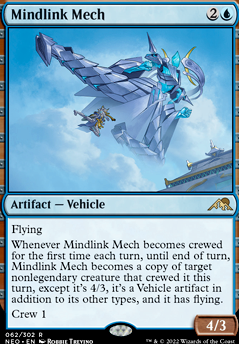
Neon Genesis Evangelion: The Deck [PRIMER]
Commander / EDH Combo Infinite Combo Jank Primer Tap/Untap Vehicle
Artifact (26)
- 1x Arcane Signet
-
1x
Bolas's Citadel

- 1x Darksteel Forge
- 1x Demonspine Whip
- 1x Gilded Lotus
- 1x Grinding Station
- 1x Howling Mine
- 1x Illusionist's Bracers
- 1x Imperial Recovery Unit
- 1x Isochron Scepter
- 1x Krark-Clan Ironworks
- 1x Lotus Petal
-
1x
Mechtitan Core

- 1x Mesmeric Orb
-
1x
Mindlink Mech

- 1x Mukotai Soulripper
- 1x Nim Deathmantle
- 1x Parhelion II
- 1x Shorikai, Genesis Engine
- 1x Smuggler's Copter
- 1x Sol Ring
-
1x
Surgehacker Mech

- 1x Talisman of Dominance
- 1x Talisman of Progress
- 1x Weatherlight
- 1x Wishclaw Talisman
Enchantment (6)
- 1x Leyline of Anticipation
- 1x March of the Machines
- 1x Mindmoil
- 1x Omniscience
- 1x Repercussion
- 1x Rhystic Study
Sorcery (5)
Land (32)
- 1x Ancient Den
- 1x Blood Crypt
- 1x City of Brass
- 1x Clearwater Pathway Flip
- 1x Command Tower
- 1x Fabled Passage
- 1x Godless Shrine
- 1x Great Furnace
- 1x Hallowed Fountain
- 4x Island
- 1x Mech Hangar
- 3x Mountain
- 1x Needleverge Pathway Flip
- 3x Plains
- 1x Riverglide Pathway Flip
- 1x Rogue's Passage
- 1x Sacred Foundry
- 1x Seat of the Synod
- 1x Spire of Industry
- 1x Steam Vents
- 2x Swamp
- 1x Tomb of the Spirit Dragon
- 1x Vault of Whispers
- 1x Watery Grave
Instant (11)
- 1x Cyclonic Rift
- 1x Dispatch
- 1x Dramatic Reversal
- 1x Entomb
- 1x Fact or Fiction
- 1x Force of Negation
- 1x Mystical Tutor
- 1x Pact of Negation
- 1x Pull from Tomorrow
- 1x Reality Heist
- 1x Valakut Awakening Flip
Planeswalker (1)
Commanders (2)
Creature (17)
- 1x Consecrated Sphinx
- 1x Dockside Extortionist
- 1x Eldrazi Displacer
- 1x Emry, Lurker of the Loch
- 1x Goblin Engineer
- 1x Greasefang, Okiba Boss
- 1x Jhoira, Weatherlight Captain
- 1x Katsumasa, the Animator
- 1x Kotori, Pilot Prodigy
- 1x Master Transmuter
- 1x Mirran Spy
- 1x Oswald Fiddlebender
- 1x Sharuum the Hegemon
- 1x Solemn Simulacrum
- 1x Stitcher's Supplier
- 1x Vedalken Archmage
- 1x Vizier of Tumbling Sands
Maybeboard
Artifact (3)
Creature (2)
Suggestions
Comments
Attention! Complete Comment Tutorial! This annoying message will go away once you do!
Important! Formatting tips — Comment Tutorial — markdown syntax
Please login to comment
92% Casual
Competitive
| Top Ranked |
|
| Date added | 2 years |
| Last updated | 2 years |
| Legality | This deck is Commander / EDH legal. |
| Rarity (main - side) | 10 - 0 Mythic Rares 54 - 0 Rares 14 - 0 Uncommons 10 - 0 Commons |
| Cards | 100 |
| Avg. CMC | 3.31 |
| Tokens | Angel 4/4 W w/ Vigilance, Copy Clone, Emblem Daretti, Scrap Savant, Mechtitan, Pilot 1/1 C, Treasure |
| Folders | A Very Cool EDH Folder, other decks, Flavorful, Stuff I like, TTS Decks, Cool, Good Primers, EDH, Interesting Decks, Inspiration |
| Votes | |
| Ignored suggestions | |
| Shared with | |
| Views |


















